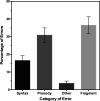Adults with cochlear implants can use prosody to determine the clausal structure of spoken sentences
- PMID: 34972310
- PMCID: PMC8674009
- DOI: 10.1121/10.0008899
Adults with cochlear implants can use prosody to determine the clausal structure of spoken sentences
Abstract
Speech prosody, including pitch contour, word stress, pauses, and vowel lengthening, can aid the detection of the clausal structure of a multi-clause sentence and this, in turn, can help listeners determine the meaning. However, for cochlear implant (CI) users, the reduced acoustic richness of the signal raises the question of whether CI users may have difficulty using sentence prosody to detect syntactic clause boundaries within sentences or whether this ability is rescued by the redundancy of the prosodic features that normally co-occur at clause boundaries. Twenty-two CI users, ranging in age from 19 to 77 years old, recalled three types of sentences: sentences in which the prosodic pattern was appropriate to the location of a clause boundary within the sentence (congruent prosody), sentences with reduced prosodic information, or sentences in which the location of the clause boundary and the prosodic marking of a clause boundary were placed in conflict. The results showed the presence of congruent prosody to be associated with superior sentence recall and a reduced processing effort as indexed by the pupil dilation. The individual differences in a standard test of word recognition (consonant-nucleus-consonant score) were related to the recall accuracy as well as the processing effort. The outcomes are discussed in terms of the redundancy of the prosodic features, which normally accompany a clause boundary and processing effort.
Figures




Similar articles
-
Congruent Prosody Reduces Cognitive Effort in Memory for Spoken Sentences: A Pupillometric Study with Young and Older Adults.Exp Aging Res. 2025 Jan-Feb;51(1):35-58. doi: 10.1080/0361073X.2023.2286872. Epub 2023 Dec 7. Exp Aging Res. 2025. PMID: 38061985
-
More Than Words: the Relative Roles of Prosody and Semantics in the Perception of Emotions in Spoken Language by Postlingual Cochlear Implant Users.Ear Hear. 2022 Jul-Aug 01;43(4):1378-1389. doi: 10.1097/AUD.0000000000001199. Epub 2022 Jan 13. Ear Hear. 2022. PMID: 35030551
-
The Role of Early Intact Auditory Experience on the Perception of Spoken Emotions, Comparing Prelingual to Postlingual Cochlear Implant Users.Ear Hear. 2024 Nov-Dec 01;45(6):1585-1599. doi: 10.1097/AUD.0000000000001550. Epub 2024 Jul 15. Ear Hear. 2024. PMID: 39004788
-
Prosodic phrasing is central to language comprehension.Trends Cogn Sci. 2006 Jun;10(6):244-9. doi: 10.1016/j.tics.2006.04.002. Epub 2006 May 2. Trends Cogn Sci. 2006. PMID: 16651019 Review.
-
The sound of thought: Form matters-The prosody of inner speech.Phys Life Rev. 2024 Dec;51:231-242. doi: 10.1016/j.plrev.2024.10.006. Epub 2024 Oct 18. Phys Life Rev. 2024. PMID: 39442498 Review.
Cited by
-
Strategic Pauses Relieve Listeners from the Effort of Listening to Fast Speech: Data Limited and Resource Limited Processes in Narrative Recall by Adult Users of Cochlear Implants.Trends Hear. 2023 Jan-Dec;27:23312165231203514. doi: 10.1177/23312165231203514. Trends Hear. 2023. PMID: 37941344 Free PMC article.
-
Listening effort and fatigue among cochlear implant users: a scoping review.Front Neurol. 2023 Nov 3;14:1278508. doi: 10.3389/fneur.2023.1278508. eCollection 2023. Front Neurol. 2023. PMID: 38020642 Free PMC article.
-
Children's Neural Sensitivity to Prosodic Features of Natural Speech and Its Significance to Speech Development in Cochlear Implanted Children.Front Neurosci. 2022 Jul 12;16:892894. doi: 10.3389/fnins.2022.892894. eCollection 2022. Front Neurosci. 2022. PMID: 35903806 Free PMC article.
References
-
- Alba, J. W. , and Hasher, L. (1983). “ Is memory schematic?,” Psychol. Bull. 93, 203–231.10.1037/0033-2909.93.2.203 - DOI
-
- Attneave, F. (1959). Applications of Information Theory to Psychology ( Holt, Rinehart, and Winston, New York, NY: ).
Publication types
MeSH terms
Grants and funding
LinkOut - more resources
Full Text Sources
Medical

